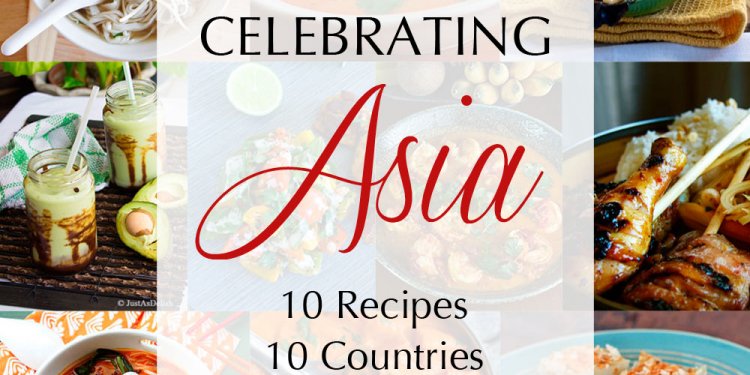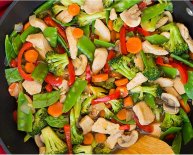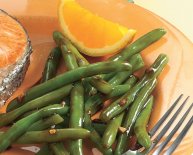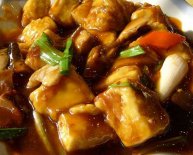
Traditional Asian food Recipes
I met Doctor Chen years ago when I went to my clinic for a checkup. She was a young, fresh-faced doctor, with a friendly bedside manner. As she looked over all my answers to the heath questionnaires, she noticed that I had described myself as vegetarian. "My parents came here from China, and at home, we still eat the Chinese way." she said. "It's funny; we might as well be vegetarians. We always have to have meat, but it's just a tiny bit, and it always seems to be the last thing we eat. It's really just there for flavor, and out of habit." I nodded, happy to talk food with a vegetable lover. Since then, I've met other first- and second-generation Asian Americans who describe the same style of eating. Rather than serving a big steak, a few slivers of beef in a stir-fry or soup—almost as a condiment—is preferred.
That brief exchange stayed in my mind, and I was reminded of it every time I read another book about Asian culture and food. It turns out the traditional diets of many Asian countries offer a good model for good health. The best-selling book The China Study, by T. Colin Campbell, and others document the increased longevity and health of followers of the original diets of China and Japan.

So, how can you incorporate some of the healthful eating habits from the traditional Asian diet into your own? The Asian Food Pyramid offers basic guidelines for the types of food to select and with what frequency. You'll notice that it has a nice broad base for grains. China, Japan, Korea and the other countries of this group follow a rice-based cuisine. There are noodles, too, and other grains, but rice is number one. Today, you can slot in all your whole grains, including brown rice in this role.
Then, fill up the majority of that pyramid of foods with plants. Plants, full of health-giving fiber, nutrients, antioxidants and great flavor, plus a little bit of plant-based oil every day. Fish and shellfish are optional daily, eggs and poultry and sweets are recommended as once-a-week treats, while meat is a once-a-month event, placed at the tip of the triangle.
Consider a traditional stir-fry. The veggies crowd the plate with color and crunch atop a pile of grains. A few slivers of protein are sparsely scattered among the veggies with animal protein used sparingly. You don't have to eat this style of stir-fry every night to practice this balance. The Korean table offers insight into another approach. Serve vegetable relishes with meals, even if you just open up some kraut or kimchi, toss a sliced cucumber with vinegar, or shred a carrot and sprinkle it with lemon. Add spoonfuls of veggie condiments alongside your meal or in your sandwich. Stepping away from the Asian table, you can pump up your veggie intake in other simple ways, like adding vegetable soup to your meal or covering half your plate with roasted veggies.
A unifying element in the healthy Asian diet model is fish and seafood. Many restaurants that serve Asian foods, though, have adjusted their dishes for the American palate, with lots of frying, and sugary, starchy sauces. Traditional old-school Asian is much simpler and lighter.
The Asian kitchen, in fact, can offer simple lessons in cooking light. Once again, take the stir-fry. A wok is heated until nearly smoking, then a tiny amount of vegetable oil is drizzled in, and a large quantity of vegetables are flash-cooked, preserving nutrients and crunch. A tasty sauce just glazes the result. Then pick up a bamboo steamer. The steamer is a model of healthy technique, in which steam gently cooks fish, dumplings, vegetables or other dishes with no fat needed. The hot pot is another model of health, a simmering pot of broth, in which foods are briefly cooked and eaten immediately.
A side benefit of eating old-school Asian is the healthfulness of fermented foods. Kimchi, preserved vegetables and pickled vegetables are all natural sources of probiotics, thanks to lactic fermentation. Miso, soy sauce, black bean paste and fish sauces are all fermented foods in which a protein has been broken down in a fermentation process that provides extra flavor and health benefits.
It's easy to adopt and adapt the guiding principles of Asian-style cooking into many of your meals. When making a big pot of whole-grain spaghetti, add chopped carrots, zucchini, mushroom, broccoli, whatever you like. Sandwiches can be tasty with just one slice of meat or cheese, and triple the lettuce, tomato and sprouts. Take a look at all your recipes and consider adding more veggies and less meat.





















